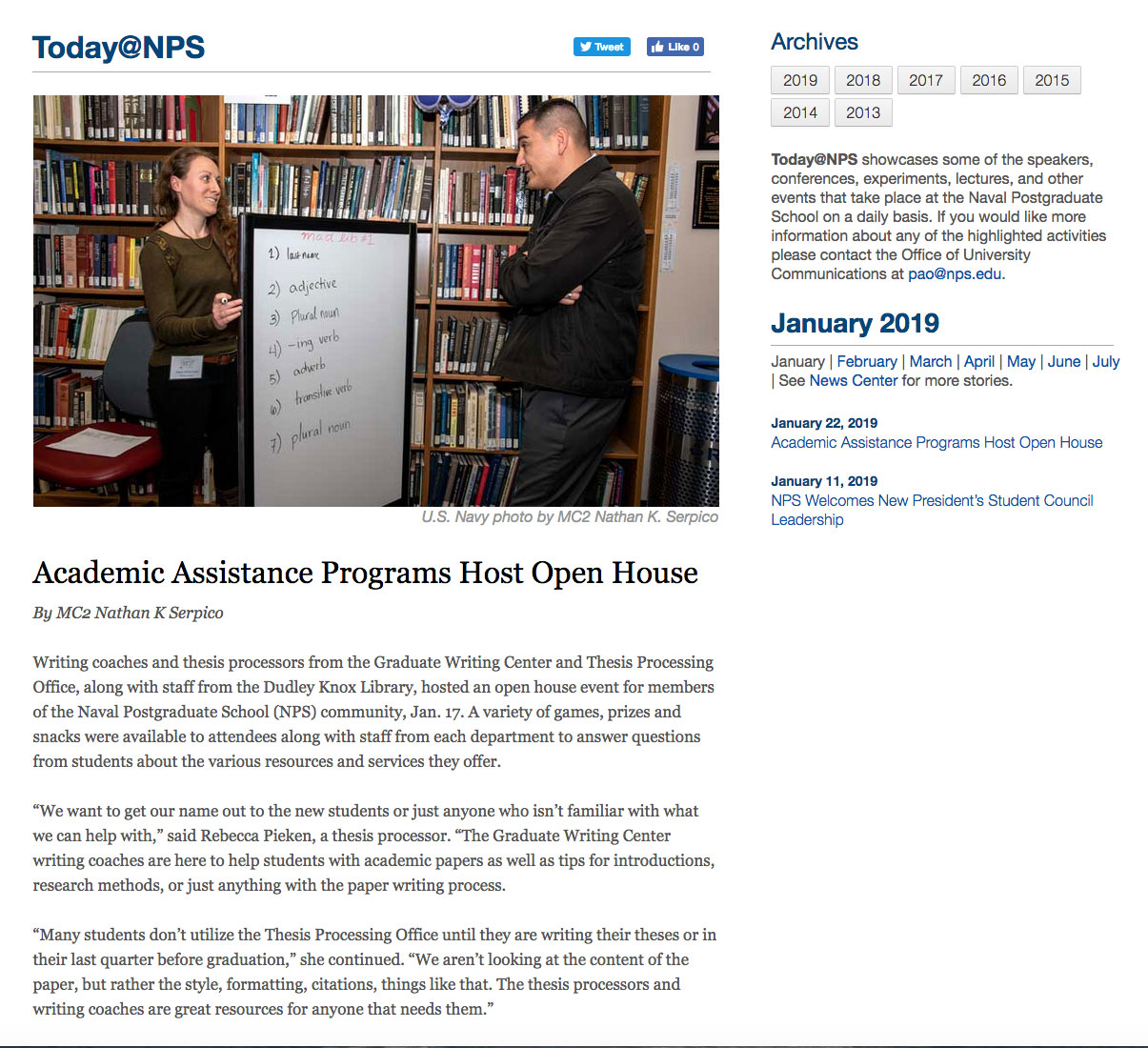The Naval Postgraduate School’s (NPS) Center for Executive Education (CEE) recently welcomed senior Department of Defense leaders to NPS to participate in a five-day Leading Innovation: Energy Application Focus (LIEAF) seminar designed to encourage innovation with a special emphasis lent to innovation in the areas of energy and conservation.
The seminar brought together the Navy Executive Development Program’s Leading Innovation Seminar and aspects of the NPS’ Cebrowski Institute Executive Energy Education Seminar in order to teach innovation skills that organizers believe will lead to enhanced mission readiness.
Seminar participants met with leading innovation thinkers from across the fleet and visited civilian industries like Google, VMWare, and IDEO to observe the manner in which they encourage innovation.
CEE Faculty Director for Innovation Initiatives, Dr. Neal Thornberry and Acting CEE Director Winli McAnally organized the seminar.
Thornberry is the author of several books on innovation, including his latest offering, “Innovation Judo: Disarming Roadblocks and Blockheads on the Path to Creativity.” Although his book was not featured in the course, the techniques described within it are indicative of his approach to teaching innovation.
“We are often asked to innovate in organizations that have a lot of built in obstacles which have developed over the years. Rules, processes, and procedures that were once meant to be helpful guidelines for behavior have morphed into bureaucratic nightmares for the innovator,” said Thornberry.
“Even the most motivated of innovators can be disillusioned in these innovation-unfriendly environments, [and] mixed leadership messages like ‘Innovate but don’t screw up”’ can further inhibit innovation,” continued Thornberry. “In my book, I teach seven secret principles that innovators can employ to keep their ideas alive despite [innovation] obstacles, especially when logic doesn’t work.”
Both Thornberry and McAnally want participants to recognize that innovation is not some far off destination, but rather an instrument whose purpose is to substantially improve an organization’s performance.
“Innovation is a tool not a destination … You can’t innovate without mistakes, it’s impossible,” said Thornberry. “In the LIEAF seminar, we want to open the aperture so that participants can see the art of the possible instead of just accepting the status quo … our main goal is to help the leaders in our course to utilize innovation thought and action to do more with less and to do it smartly.”
Thornberry and McAnally do this by, amongst other things, helping seminar participants to recognize their innate ability to be innovative.
“We are trying to make them aware that innovation is a friend and that even if they do not feel like they are naturally innovative, that they as human beings are actually hard-wired for it” said Thornberry.
While seminar attendees applied innovation tools to energy and other areas, they were also made cognizant of current fiscal and resource restraints within the DOD. Several course participants shared lessons-learned on this and related innovation topics.
Rear Adm. Marcus Hitchcock with Fleet Forces Command attended the seminar and recognized the need to find innovative ways to do more with less.
“It’s been a great week to learn some different concepts and lessons in regard to innovation. We have squeezed a lot of efficiencies out of the Navy, and if we are going to continue to make gains in light of our current restraints, we will have to figure out how we can innovate with what we have,” said Hitchcock.
Rear Adm. Colin J. Kilrain, Assistant Commanding Officer with the Joint Special Operations Command at Fort Bragg, N.C., recognized the tendency for organizations to become self-limiting and to kill innovation.
“We sometimes run the risk of falling into groupthink. This kind of seminar really adds dynamism and diversity to the organization and helps us to break out of that mindset,” said Kilrain. “Too often we get caught up with our daily duties, we become slaves to our e-mails and lose focus. It’s great to come to these seminars, connect with other leaders and look at things holistically.”
Rear Adm. Daniel H. Fillion, U.S. Southern Command’s Director of Strategy, Policy and Plans (J5) commented on the need to foster innovation throughout his organization.
“The innovative solution to the problem that you are facing may not come from a guy like me, it can happen at every level,” said Fillion. “Innovation will not just jump out and hit you in the face, you have to encourage it and you yourself have to make it work.
“I learned [during an industry visit] that every idea gets a ‘sticky’ on the board and that every idea has merit … it may not seem to make sense at the time, but no idea at its inception is thrown out, it may not become the solution-set, but it may become a component of the solution,” added Fillion.
McAnally and Thornberry asked Fillion and his colleagues to take their ideas off the board and run them through an opportunity analysis.
“Ideas are a dime a dozen but opportunities are rare, so we help participants differentiate great ideas from great opportunities,” said Thornberry. “We ask [the question], ‘If implemented, is your idea durable, sustainable, defensible, and value creating?’”
Kilrain called Thornberry’s process, “one of the most valuable things we learned.” As a Navy Seal, he is no stranger to innovative thinking.
“We Seals have always prided ourselves on being an innovative organization that demands collaboration and innovation at all levels. Our best leaders don't become anchored to the degree that they cannot adjust to a change in plans,” said Kilrain.
“Outside thinkers from industry and academia do a very good job of providing us with the intellectual expertise and environments that allow us to look at problems differently so that we can gain insight into other ways of doing things,” he added. “The next war is going to require some different thinking. Our biggest challenge will be to ensure that we have the mental agility to adapt, and that we are able to draw upon our culture of innovation.”


